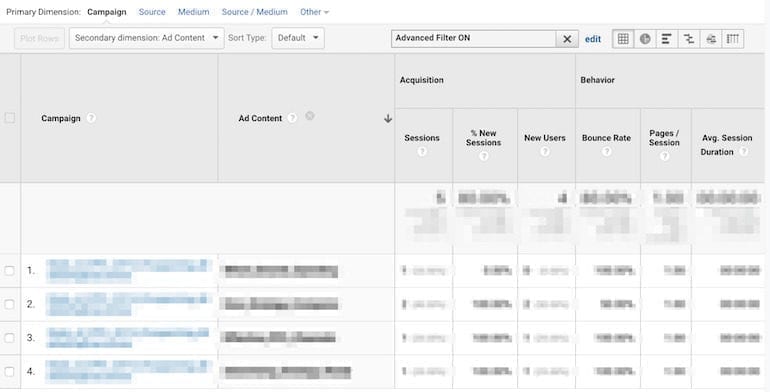Indicators on What Is A Secondary Dimension In Google Analytics You Should Know
Wiki Article
Not known Incorrect Statements About What Is A Secondary Dimension In Google Analytics
Table of ContentsThe 9-Second Trick For What Is A Secondary Dimension In Google AnalyticsThe 8-Minute Rule for What Is A Secondary Dimension In Google AnalyticsThe Single Strategy To Use For What Is A Secondary Dimension In Google AnalyticsThe Only Guide for What Is A Secondary Dimension In Google AnalyticsWhat Is A Secondary Dimension In Google Analytics Fundamentals ExplainedWhat Is A Secondary Dimension In Google Analytics Fundamentals Explained
If this does not sound clear, below are some examples: A purchase happens on a site. Its measurements can be (but are not restricted to): Transaction ID Voucher code Newest website traffic resource, etc. An individual logs in to an internet site, as well as we send the occasion login to Google Analytics. That event's custom dimensions could be: Login approach Customer ID, and so on.Thus customized measurements are needed. In Google Analytics, you will certainly not locate any dimensions relevant particularly to online programs.

Go Into Custom Dimensions. In this blog site article, I will certainly not dive deeper right into custom dimensions in Universal Analytics.
Indicators on What Is A Secondary Dimension In Google Analytics You Need To Know
The scope specifies to which events the dimension will apply. In Universal Analytics, there were four ranges: User-scoped personalized measurements are related to all the hits of a user (hit is an event, pageview, etc). As an example, if you send out Customer ID as a custom-made dimension, it will certainly be related to all the hits of that specific session as well as to all the future hits sent out by that customer (as long as the GA cookie remains the same).You can send the session ID personalized dimension, and even if you send it with the last occasion of the session, all the previous occasions (of the same session) will certainly get the value. This is done in the backend of Google Analytics. dimension applies just to that certain event/hit (with which the measurement was sent out).
That dimension will certainly be used just to the "trial started" event. Product-scoped custom dimension applies just to a particular product (that is tracked with Improved Ecommerce functionality). Also if you send several items with the very same deal, each product might have various worths in their product-scoped custom-made measurements, e. g.
The Only Guide to What Is A Secondary Dimension In Google Analytics
Why am I informing you this? Since some points have actually transformed in Google Analytics 4. In Google Analytics 4, the session extent is no much longer readily available (a minimum of in personalized dimensions). Google stated they would add session-scope in the future to GA4. If you intend to apply a measurement to all the events of a specific session, you should send out that dimension with every occasion (that can be done on the code level (gtag) or in GTM).It can be in a cookie, data layer, or elsewhere. From currently on, personalized measurements are either hit-scoped or user-scoped (previously understood as Customer Residences). User-scoped personalized dimensions in GA4 work in a similar way to the user-scoped measurements in Universal Analytics but with some distinctions: In Universal Analytics, a user-scoped personalized dimension (collection in the middle of visit the website the individual session) was used to EVERY event of the same session (also if some occasion happened before the dimension was set).
Little Known Facts About What Is A Secondary Dimension In Google Analytics.
Although you can send out customized item information to GA4, presently, there is no chance to see it in records properly. With any luck, this will be transformed in the future. Or am I missing something? (allow me understand). GA4 now sustains item-scoped customized measurements. At some time in the past, Google claimed that session-scoped customized measurements in GA4 would be readily available too.Yet when it involves personalized dimensions, this scope is still not offered. As well as now, let's relocate to the 2nd part of this blog site article, where I will show you just how to configure custom-made dimensions and where to discover them in Google Analytics 4 reports. Let me start with a basic overview of the procedure, and then we'll take an appearance at an instance.
You can simply send the occasion name, claim, "joined_waiting_list" as well as after that consist of the parameter "course_name".
How What Is A Secondary Dimension In Google Analytics can Save You Time, Stress, and Money.
In that instance, you will certainly need to: Register a specification as a custom-made interpretation Begin sending out customized specifications with the occasions you want The order DOES NOT matter right here. You ought to do that rather a lot at the very same time. If you begin sending out the parameter to Google Analytics 4 and just register it as a customized measurement, state, one week later on, your reports will certainly be missing that a person week of data (due to the fact that the registration of a customized dimension is not retroactive).Every time a site visitor clicks on a menu item, I will send an occasion as well as 2 additional specifications (that I will later on sign up as custom dimensions), menu_item_url, and also menu_item_name.: Food selection link click tracking trigger conditions differ on a lot of websites (because of different click courses, IDs, etc). Try to do your read what he said finest to use this instance.
Go to Google Tag Manager > Causes > New > Just Hyperlinks. By developing this trigger, we will certainly enable the link-tracking capability in Google Tag Manager.
More About What Is A Secondary Dimension In Google Analytics
Go to your internet site and click any of the menu links. Click the initial click this Web link, Click event and also go to the Variables tab of the preview setting.
Report this wiki page